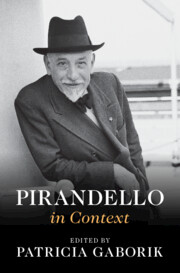Book contents
- Pirandello in Context
- Pirandello in Context
- Copyright page
- Dedication
- Contents
- Figures
- Contributors
- Preface
- Acknowledgments
- Chronology
- List of Cited Titles in Translation and the Original Italian
- Part I Places
- Part II Institutions
- Part III Interlocutors
- Part IV Traditions and Trends, Techniques and Forms
- Part V Culture and Society
- Chapter 25 History
- Chapter 26 Celebrity
- Chapter 27 Cinema
- Chapter 28 Modernity
- Chapter 29 Fascism
- Chapter 30 Women
- Chapter 31 Religion
- Chapter 32 Madness
- Chapter 33 Suicide
- Part VI Reception and Legacy
- Further Reading
- Index
Chapter 30 - Women
from Part V - Culture and Society
Published online by Cambridge University Press: 14 March 2024
- Pirandello in Context
- Pirandello in Context
- Copyright page
- Dedication
- Contents
- Figures
- Contributors
- Preface
- Acknowledgments
- Chronology
- List of Cited Titles in Translation and the Original Italian
- Part I Places
- Part II Institutions
- Part III Interlocutors
- Part IV Traditions and Trends, Techniques and Forms
- Part V Culture and Society
- Chapter 25 History
- Chapter 26 Celebrity
- Chapter 27 Cinema
- Chapter 28 Modernity
- Chapter 29 Fascism
- Chapter 30 Women
- Chapter 31 Religion
- Chapter 32 Madness
- Chapter 33 Suicide
- Part VI Reception and Legacy
- Further Reading
- Index
Summary
An innovator in art, a revolutionary in his philosophical ideas and his conception of narrative and drama, the 1934 Nobel Prize-winner in literature was in life a conservative from Sicily – a place with a dichotomic perception of women, who were either worshipped as Mother-Madonnas or feared as erotic females. Pirandello was, moreover, the product of the old Western tradition that since the time of Plato and Aristotle juxtaposed male spirit to female matter, viewing reason and speculation as belonging to men and instinct and procreation to women. At the same time, Pirandello was aware that a male culture created the condition of women as victims. Thus in his works we see a combination of these ideas: Sexual phobias are exorcised in short stories about the awakening of sexual feelings (especially in girls), and women are depicted as closer to life and thus artistic creation than men. In his plays, he viewed the theatre as a place of renewal and thus women become capable of breaking taboos and social norms there and of asserting their own autonomy.
Keywords
- Type
- Chapter
- Information
- Pirandello in Context , pp. 243 - 249Publisher: Cambridge University PressPrint publication year: 2024

